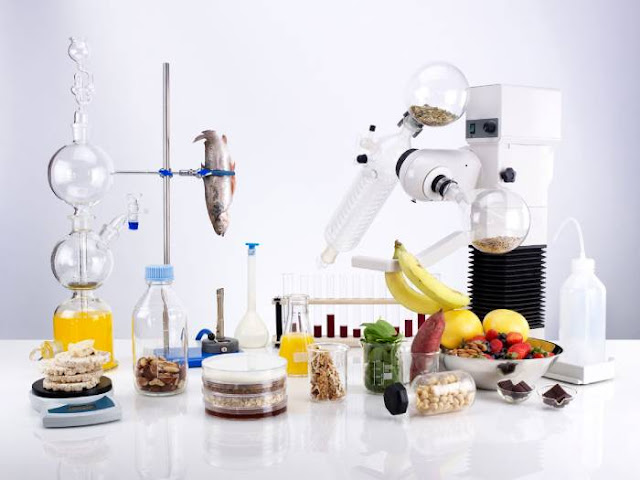- Get link
- X
- Other Apps
Food Science and Technology, coupled with sound nutrition practices, wield a significant influence over the health of our planet and its inhabitants. In the face of snowballing global challenges such as climate change, resource depletion, and a growing global population, these fields play a pivotal role in steering us towards a sustainable future. By comprehensively addressing these intertwined issues, we can strive for a healthier planet and improved human well-being.
The world's people is likely to reach 9 billion by 2050,
intensifying the pressure on agricultural systems and natural resources. To
sustainably feed this population, innovative solutions are imperative. Food
Science and Technology have a crucial role in enhancing food production, preservation,
and distribution. The development of advanced techniques for food processing,
packaging, and storage can significantly minimize post-harvest losses and range
the shelf life of perishable goods. This not only ensures more efficient
resource utilization but also reduces the overall environmental footprint of
the food industry.
Moreover, Food Science and Technology can facilitate the
utilization of alternative food sources. For instance, utilizing edible insects
or plant-based proteins as alternatives to traditional livestock can mitigate
the environmental impact associated with intensive animal farming. These
innovations can address food security concerns while diminishing greenhouse gas
emissions, deforestation, and water consumption.
Nutrition, intertwined with food choices, is a powerful
determinant of public health. The adoption of bearable dietary patterns, such
as the Mediterranean diet or plant-based diets, can mitigate the prevalence of
chronic diseases and simultaneously reduce environmental burdens. Such diets
typically emphasize whole grains, legumes, fruits, vegetables, and nuts, which
have lower carbon and water footprints compared to resource-intensive
animal-based products. By promoting these dietary choices, we not only enhance
human health but also alleviate pressure on land and water resources.
Food processing techniques can affect the nutritional
composition of foods. While some processes might lead to nutrient losses,
others can enhance bioavailability and extend the availability of certain
nutrients. Fortification, for example, can address micronutrient deficiencies
that plague various populations globally. By strategically fortifying staple
foods, we can combat malnutrition and its associated health complications.
However, the benefits of Food Science and Technology can be
maximized only when coupled with adequate nutrition education. Empowering
individuals to make informed food choices is essential for private health and
the health of the planet. Understanding labels, recognizing nutrient-rich
foods, and grasping the environmental implications of dietary decisions can
collectively shape sustainable behaviors. Educational initiatives can bridge
the gap between scientific knowledge and everyday practices, propelling
societies towards better health outcomes and reduced environmental impact.
The efficient use of resources in food production is central
to planet health. Agriculture accounts for a significant portion of global orangery
gas emissions, water usage, and land transformation. Sustainable agricultural
practices, backed by scientific insights, can mitigate these impacts. Precision
agriculture, which employs technology to optimize resource use, reduces the
need for excess fertilizers and water while enhancing yields. Furthermore,
integrated pest management techniques can curtail the use of harmful
pesticides, safeguarding ecosystems and human health.
In the pursuit of sustainability, reducing food waste is
paramount. Approximately one-third of all food produced goes to waste,
exacerbating resource depletion and environmental degradation. Innovative
packaging technologies, such as intelligent labels that monitor freshness, can
help extend the shelf life of products and reduce waste. Additionally,
redirecting surplus food to those in need can address both food insecurity and
wastage concerns.
Collaboration between stakeholders is vital in promoting
sustainable practices. Governments, industries, and consumers must collaborate
to implement policies that incentivize sustainable food production, support
research, and ensure equitable access to nutritious foods. Subsidies that favor
healthier and environmentally friendly food options can steer consumption
patterns in the right direction. Furthermore, partnerships between food scientists,
nutritionists, and environmental experts can yield holistic solutions that
address multiple challenges simultaneously.
What is the relationship between food science and food technology?
Food science and food technology are closely intertwined
disciplines. Food science involves studying the composition, structure, and
properties of foods, as well as their interactions during processing and
storage. Food technology applies scientific knowledge to develop practical
methods and techniques for processing, preserving, packaging, and distributing
food products. While food science provides the foundational understanding of
food components and their behavior, food technology translates this knowledge
into real-world applications. In essence, food science generates the knowledge,
and food technology applies that knowledge to create safe, nutritious, and
convenient food products for consumers.
Conclusion
The nexus of Food Science and Technology, along with nutrition, holds unparalleled potential for enhancing the health of our planet and its inhabitants. By leveraging innovative food processing, sustainable agricultural practices, and informed dietary choices, we can address the pressing challenges of resource scarcity, climate change, and public health. A future where food is produced, distributed, and consumed sustainably is within reach, and it necessitates the collective commitment of individuals, industries, and governments. Through these concerted efforts, we can foster a healthier planet for current and future generations.
- Get link
- X
- Other Apps
